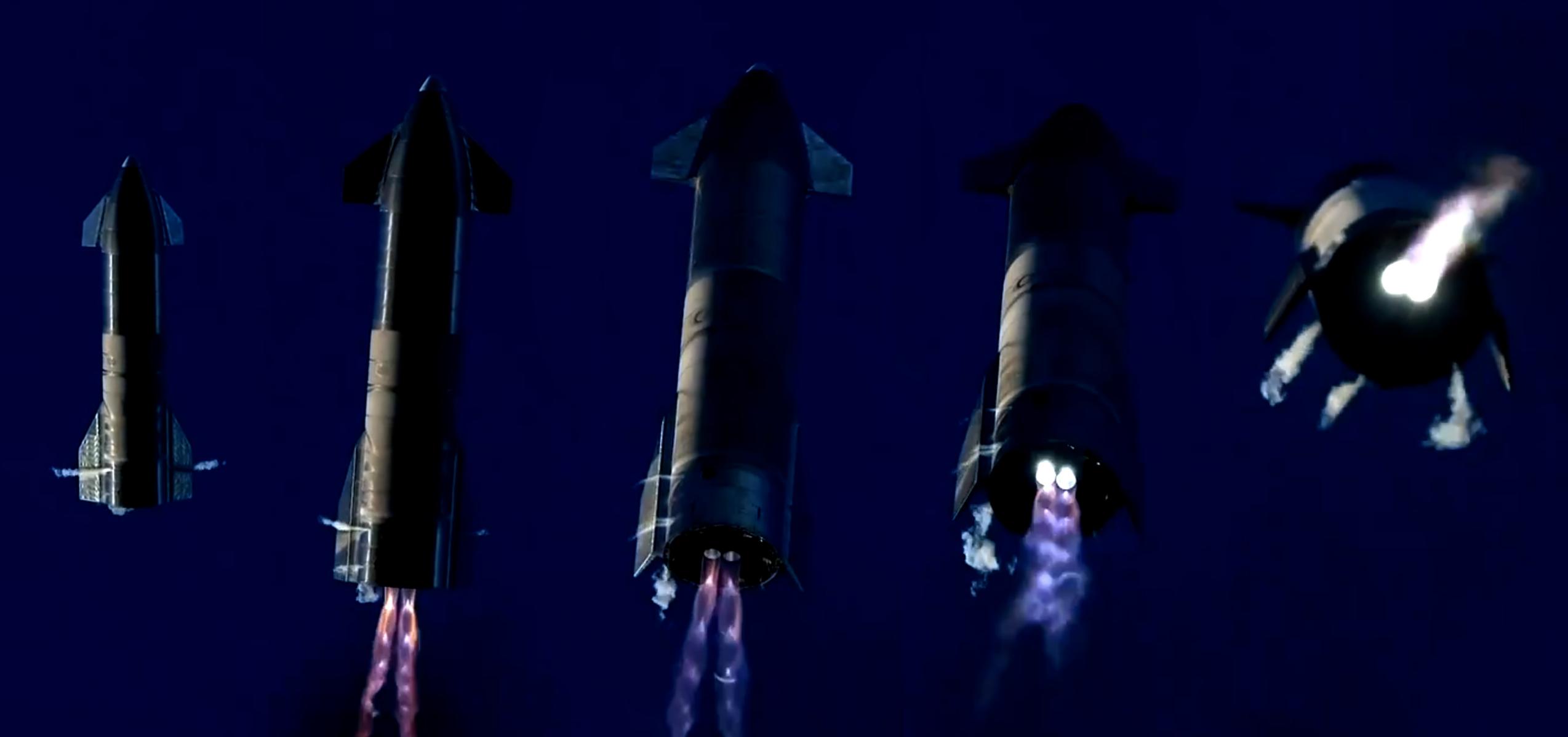
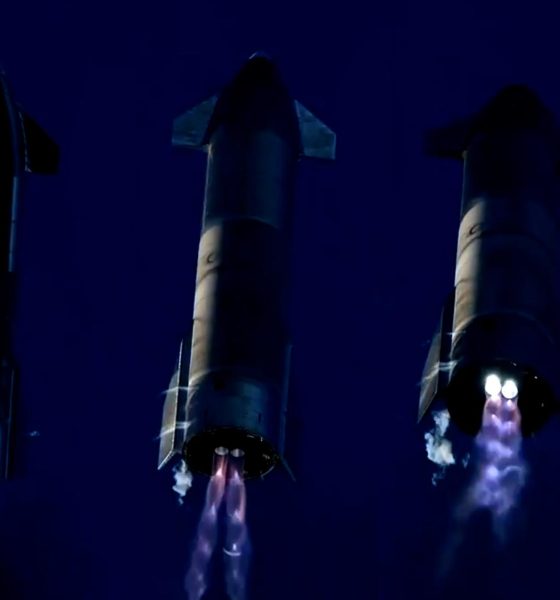
News
SpaceX Starship nails ‘flip’ maneuver in explosive landing video
Update: SpaceX has published a video taken near the launch pad of Starship nailing an exotic ‘flip’ maneuver shortly before a hard landing destroyed the rocket.
Both the company, test directors, and CEO Elon Musk have all made it abundantly clear that despite the explosive end, Starship SN8’s maiden flight was a spectacular success, proving that the rocket is capable of performing several previously-unproven maneuvers and surviving the associated stresses. Notably, according to tweets posted by Musk not long after, Starship SN8 performed almost perfectly, failing a soft landing (already proven by SN5 and SN6) solely because of low pressure in the rocket’s secondary ‘header’ fuel tank.
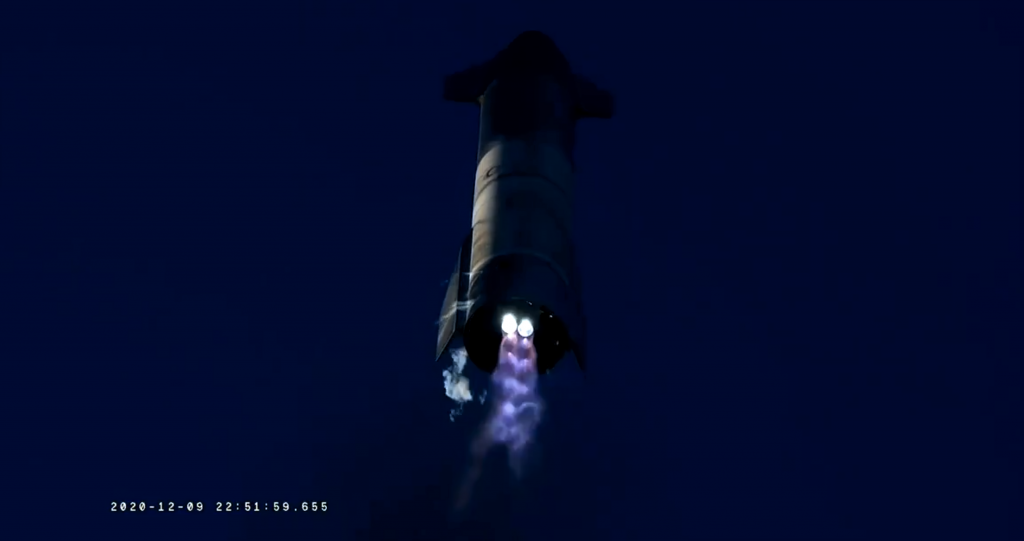
For unknown reasons, that tank or its associated plumbing were unable to maintain the pressure needed to feed Raptor with enough propellant, resulting in fuel starvation mid-burn. A lack of fuel and surplus of oxygen effectively turned the landing engine into a giant oxygen torch, melting the copper walls of its combustion chamber (hence the green plume). Had the header tank maintained the correct pressure, SN8 would have very likely landed intact (or at least had a much softer landing).
In simpler terms, it seems that Raptor isn’t to blame for Starship SN8’s failed landing and fixing a pressurization problem will be dramatically faster and easier than rectifying a rocket engine design flaw.
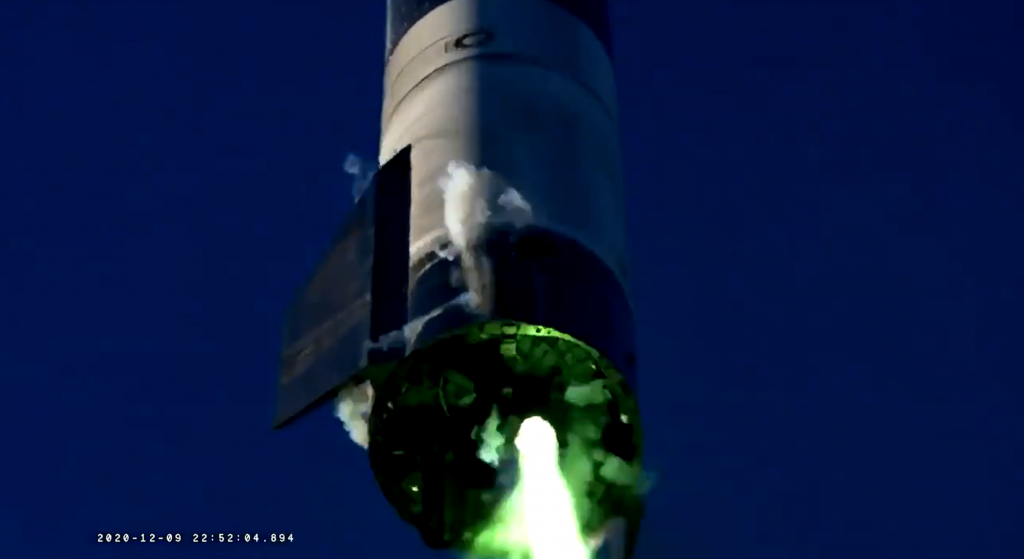
In perhaps the most spectacular aerospace demonstration since Falcon Heavy’s 2018 debut, SpaceX’s first full-size Starship prototype came within a hair’s breadth of sticking the landing after an otherwise successful ~12.5 km (7.8 mi) launch debut.
To quote SpaceX’s test director, heard live on the company’s official webcast moments after Starship serial number 8 (SN8) exploded on impact, “Incredible work, team!” For most, praise shortly after a rocket explosion could easily feel nonsensical, but in the context of SpaceX’s iterative approach to development, a Starship prototype failing just moments before the end of a multi-minute test can be considered a spectacular success.
Chock full of surprises, Starship SN8 ignited its three Raptor engines for the third time and lifted off at 4:45 pm CST (UTC-6) on the program’s high-altitude launch debut.
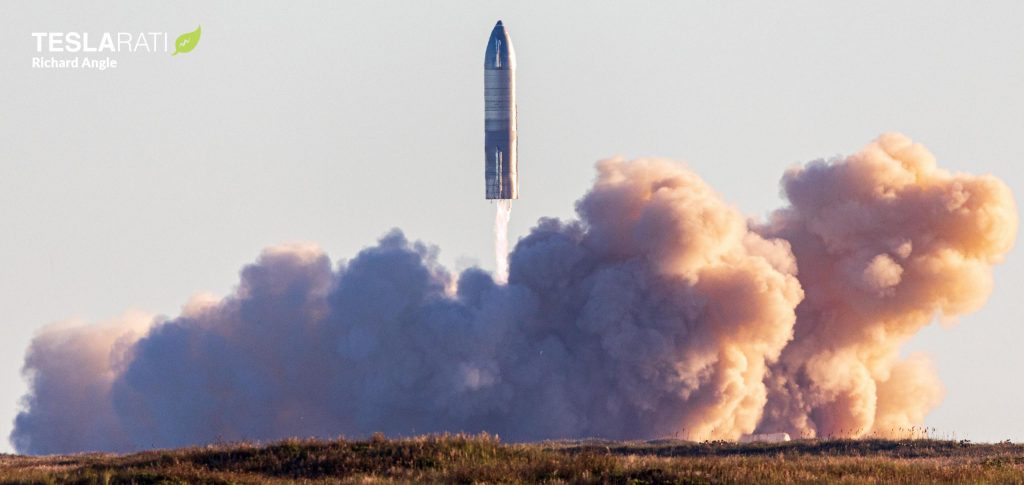
About 100 seconds after liftoff, already representing the longest-known ignition of one – let alone three – Raptor engines, one of those three engines appeared to shut down, causing the two remaining engines to gimbal wildly in an effort to retain control. Another two minutes after that, one of those Raptors also shut down, leaving one engine active. That one engine continued to burn for another minute and a half, producing just enough thrust to more or less maintain Starship SN8’s altitude at apogee while performing a bizarre horizontal slide maneuver.
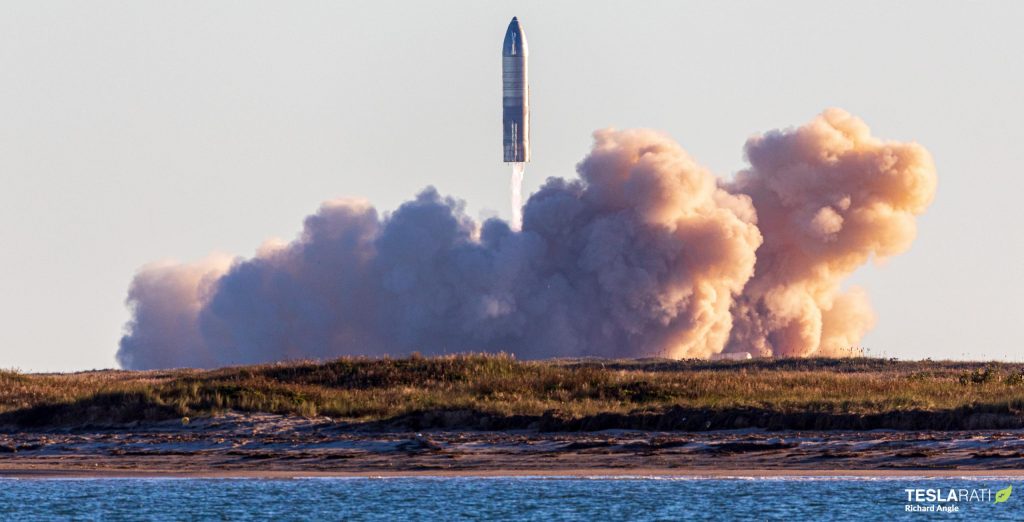
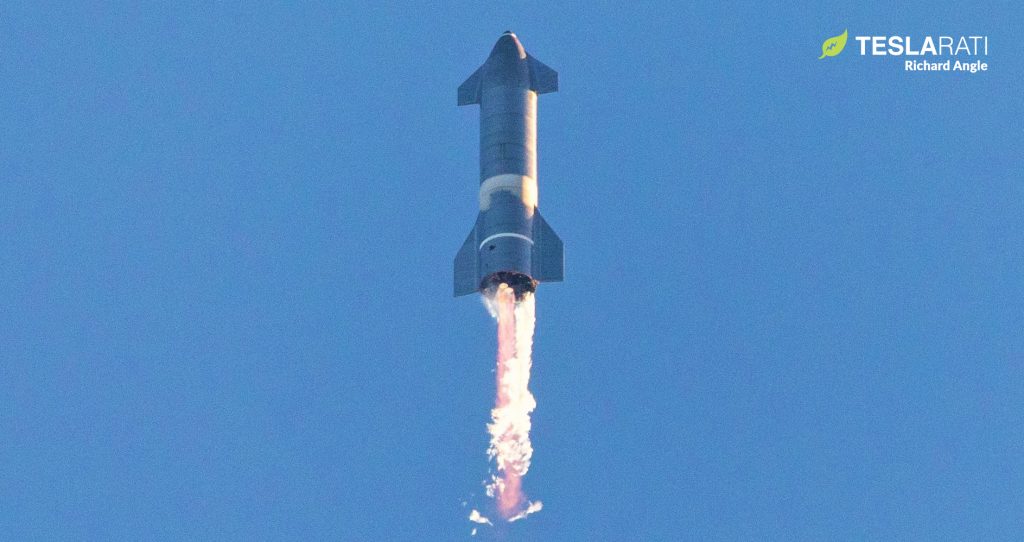

Finally, at a bit less than five minutes after liftoff, Starship cut off all Raptor engines and began falling back to earth. Looking spectacularly similar to fan-made renders and CGI videos of the highly-anticipated ‘skydiver’ or ‘belly-flop’ maneuver, Starship – belly down – spent around two minutes in a rock-solid freefall, using four large flaps to maintain stability.
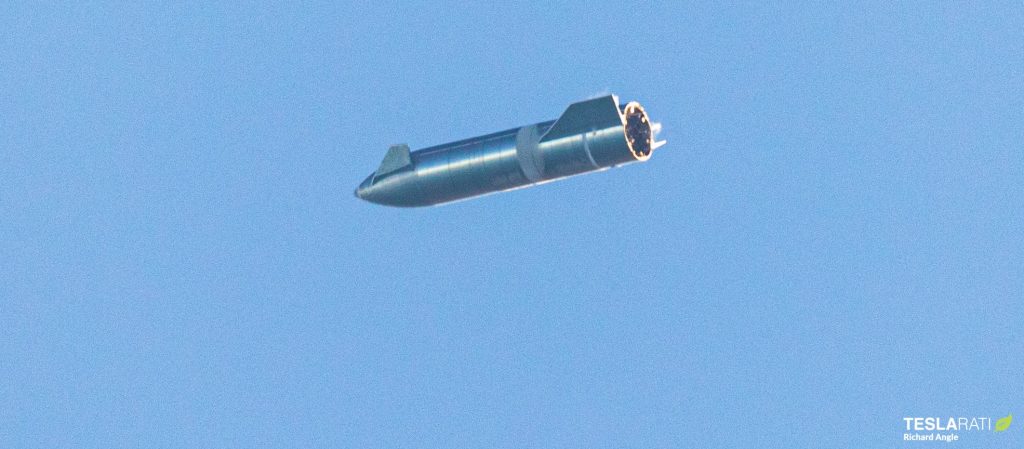


Around 4:52 pm, Starship SN8 performed exactly as expected, igniting one – and then two – Raptor engines while fully parallel to the ground to complete an aggressive 90-degree flip, transitioning into vertical flight for an attempted landing. Unfortunately, although it’s difficult to judge what was intentional and what was not, things began to go wrong after that point -visible in the form of one of the two reignited Raptors flashing green before shutting down.
At the same time, the plume of the lone remaining engine flashed an electric green, quite literally consuming its copper-rich internals in an unsuccessful attempt to slow Starship down. According to SpaceX CEO Elon Musk, Raptor performed “great” throughout the launch and landing attempt, with the bright-green plume likely explained by extremely oxygen-rich combustion caused by low “fuel header tank pressure.”
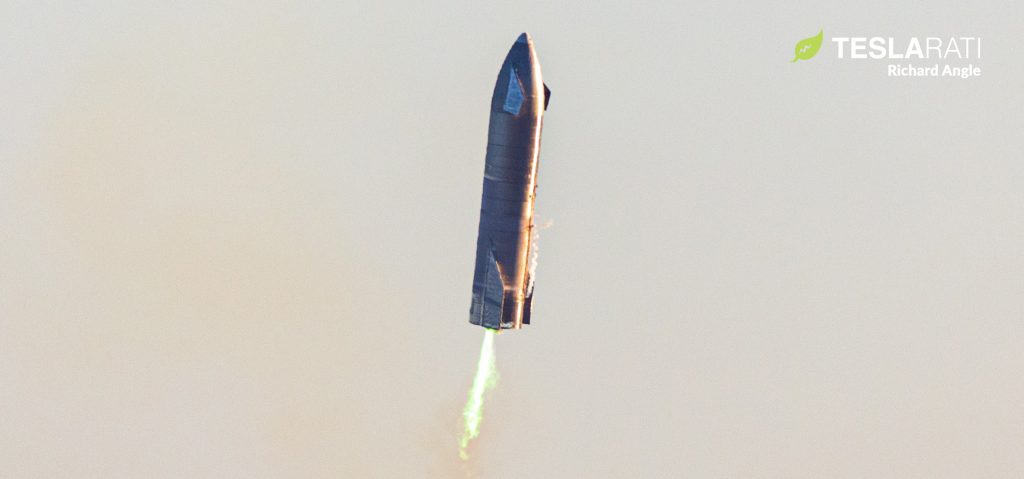
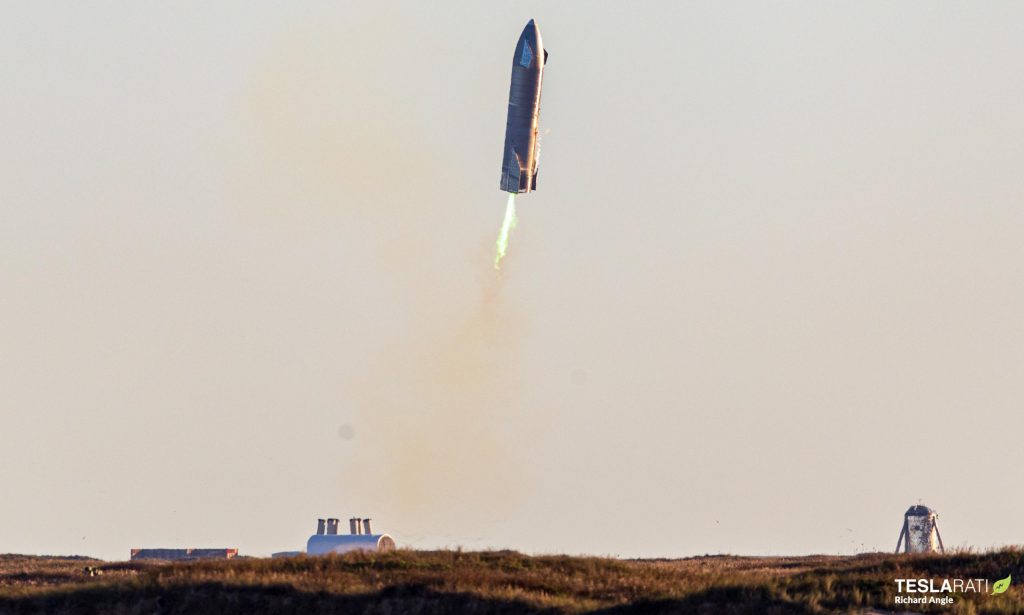
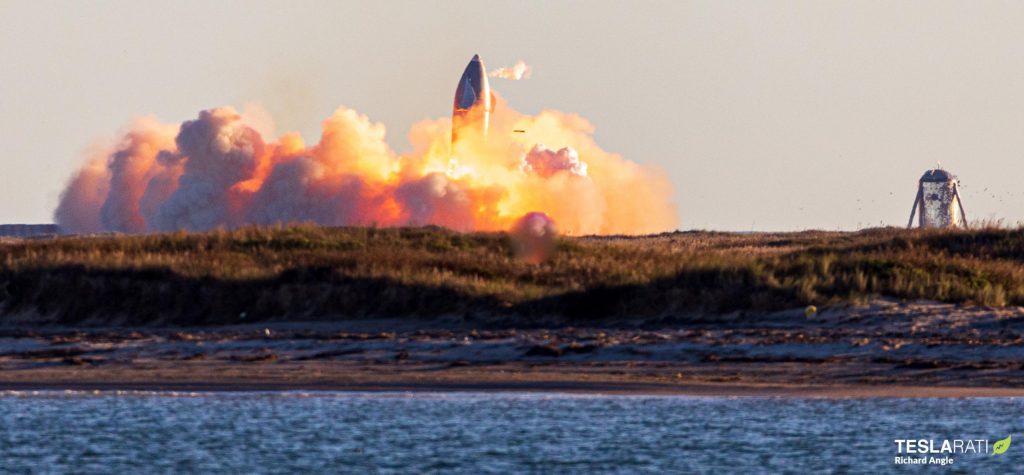
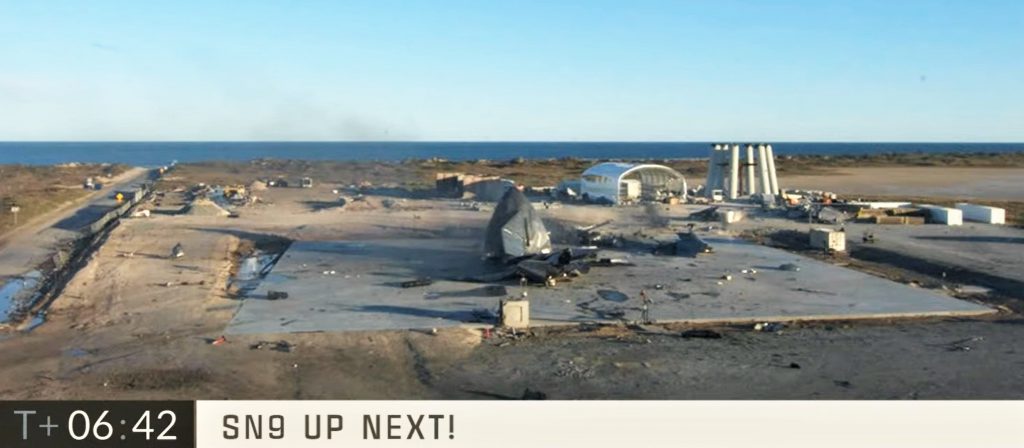
Regardless of the specific cause, Starship SN8 smashed into the ground around 10-20 seconds early, traveling about 30 m/s (~70 mph) too fast. To be clear, in SpaceX’s eyes, the test – primarily focused on demonstrating multi-engine ascent, freefall stability, header tank handover, engine reignition, and a flip-over maneuver – was a spectacular success, completing almost every single objective and seemingly doing so without any major issues.
Clocking in at an incredible (and unexpected) ~400 seconds (~6.5 minutes) from liftoff to explosion, it’s difficult to exaggerate the sheer quantity of invaluable data SpaceX has likely gathered from SN8’s sacrifice. Thanks to SN8’s primarily successful debut, SpaceX’s Starship test and launch facilities (minus the rocket’s remains on the landing zone) appear to be almost completely unharmed, likely requiring only minor repairs and refurbishment. Further, Starship SN9 is effectively complete and patiently waiting a few miles down the road, ready to roll to the launch pad almost as soon as SpaceX has understood the cause of SN8’s hard landing.
Stay tuned for more analysis, photos, and videos as the dust settles.

News
Tesla hints at Starlink integration with recent patent
“By employing polymer blends, some examples enable RF transmission from all the modules to satellites and other communication devices both inside and outside the vehicle.”

Tesla hinted at a potential Starlink internet terminal integration within its vehicles in a recent patent, which describes a vehicle roof assembly with integrated radio frequency (RF) transparency.
The patent, which is Pub. No U.S. 2025/0368267 describes a new vehicle roof that is made of RF-transparent polymer materials, allowing and “facilitating clear communication with external devices and satellites.”
Tesla believes that a new vehicle roof design, comprised of different materials than the standard metallic or glass elements used in cars today, would allow the company to integrate modern vehicular technologies, “particularly those requiring radio frequency transmission and reception.
Tesla has recently filed a US patent application on integrating RF transparent materials into the roof structure.
“facilitating clear communication with external devices and satellites”
Tesla fleet is getting @Starlink connectivity integration soon. LFG @Tesla @elonmusk… pic.twitter.com/bLa8YtPLd1
— Chansoo Byeon (@Chansoo) December 9, 2025
Instead of glass or metallic materials, Tesla says vehicles may benefit from high-strength polymer blends, such as Polycarbonate, Acrylonitrile Butadiene Styrene, or Acrylonitrile Styrene Acrylate.
These materials still provide ideal strength metrics for crashworthiness, stiffness for noise, vibration, and harshness control, and are compliant with head impact regulations.
They would also enable better performance with modern technologies, like internet terminals, which need an uninterrupted signal to satellites for maximum reception. Tesla writes in the patent:
“By employing polymer blends, some examples enable RF transmission from all the modules to satellites and other communication devices both inside and outside the vehicle.”

One of the challenges Tesla seems to be aware of with this type of roof design is the fact that it will still have to enable safety and keep that at the forefront of the design. As you can see in the illustration above, Tesla plans to use four layers to increase safety and rigidity, while also combating noise and vibration.
It notes in the patent that disclosed examples still meet the safety requirements outlined in the Federal Motor Vehicle Safety Standards (FMVSS).
Starlink integrated directly into Tesla vehicles would be a considerable advantage for owners. It would come with a handful of distinct advantages.
Initially, the inclusion of Starlink would completely eliminate cellular dead zones, something that is an issue, especially in rural areas. Starlink would provide connectivity in these remote regions and would ensure uninterrupted service during road trips and off-grid adventures.
It could also be a critical addition for Robotaxi, as it is crucial to have solid and reliable connectivity for remote monitoring and fleet management.
Starlink’s growing constellation, thanks to SpaceX’s routine and frequent launch schedule, will provide secure, stable, and reliable internet connectivity for Tesla vehicles.
Although many owners have already mounted Starlink Mini dishes under their glass roofs for a similar experience, it may be integrated directly into Teslas in the coming years, either as an upgrade or a standard feature.
News
Tesla supplements Holiday Update by sneaking in new Full Self-Driving version
It seems Tesla was waiting for the Hardware 4 rollout, as it wanted to also deploy a new Full Self-Driving version to those owners, as it appeared in the release notes for the Holiday Update last night.

Tesla has surprised some owners by sneaking in a new Full Self-Driving version with the wide release of the Holiday Update, which started rolling out to Hardware 4 owners on Friday night.
Tesla has issued a controlled and very slow release pattern with the Holiday Update, which rolls out with Software Version 2025.44.25.5.
For the past two weeks, as it has rolled out to Hardware 3 and older Tesla owners, the company has kept its deployment of the new Software Version relatively controlled.
It seems Tesla was waiting for the Hardware 4 rollout, as it wanted to also deploy a new Full Self-Driving version to those owners, as it appeared in the release notes for the Holiday Update last night.
Tesla Full Self-Driving v14.2.1.25 made its first appearance last night to Hardware 4 owners who are members of the Early Access Program (EAP). It appears to be a slight refinement from FSD v14.2.1, which has been out for a couple of weeks.
Tesla v2025.44.25.5 Holiday update incoming
Also Full Self-Driving v14.2.1.25!!! pic.twitter.com/74D7S0UGXz
— TESLARATI (@Teslarati) December 13, 2025
Many owners welcome the new FSD version, us included, because we’ve been less than impressed with v14.2.1. We have experienced some minor regressions with v14.2.1, especially with Speed Limit recognition, Speed Profile tinkering, and parking performance.
As it stands, Full Self-Driving is still particularly impressive, but Tesla is evidently having an issue with some of the adjustments, as it is still refining some of the performance aspects of the suite. This is expected and normal with some updates, as not all of them are an improvement in all areas; we routinely see some things backtrack every once in a while.
This new FSD version is likely to take care of those things, but it also includes all of the awesome Holiday Update features, which include:
- Grok with Navigation Commands (Beta) – Grok will now add and edit destinations.
- Tesla Photobooth – Take pictures inside your car using the cabin-facing camera
- Dog Mode Live Activity – Check on your four-legged friend on your phone through periodic snapshots taken of the cabin
- Dashcam Viewer Update – Includes new metrics, like steering wheel angle, speed, and more
- Santa Mode – New graphics, trees, and a lock chime
- Light Show Update – Addition of Jingle Rush light show
- Custom Wraps and License Plates – Colorizer now allows you to customize your vehicle even further, with custom patterns, license plates, and tint
- Navigation Improvements – Easier layout and setup
- Supercharger Site Map – Starting at 18 pilot locations, a 3D view of the Supercharger you’re visiting will be available
- Automatic Carpool Lane Routing – Navigation will utilize carpool lanes if enabled
- Phone Left Behind Chime – Your car will now tell you if you left a phone inside
- Charge Limit Per Location – Set a charge limit for each location
- ISS Docking Simulator – New game
- Additional Improvements – Turn off wireless charging pad, Spotify improvements, Rainbow Rave Cave, Lock Sound TRON addition
Tesla also added two other things that were undocumented, like Charging Passport and information on USB drive storage to help with Dashcam.
Cybertruck
Tesla updates Cybertruck owners about key Powershare feature

Tesla is updating Cybertruck owners on its timeline of a massive feature that has yet to ship: Powershare with Powerwall.
Powershare is a bidirectional charging feature exclusive to Cybertruck, which allows the vehicle’s battery to act as a portable power source for homes, appliances, tools, other EVs, and more. It was announced in late 2023 as part of Tesla’s push into vehicle-to-everything energy sharing, and acting as a giant portable charger is the main advantage, as it can provide backup power during outages.
Cybertruck’s Powershare system supports both vehicle-to-load (V2L) and vehicle-to-home (V2H), making it flexible and well-rounded for a variety of applications.
However, even though the feature was promised with Cybertruck, it has yet to be shipped to vehicles. Tesla communicated with owners through email recently regarding Powershare with Powerwall, which essentially has the pickup act as an extended battery.
Powerwall discharge would be prioritized before tapping into the truck’s larger pack.
However, Tesla is still working on getting the feature out to owners, an email said:
“We’re writing to let you know that the Powershare with Powerwall feature is still in development and is now scheduled for release in mid-2026.
This new release date gives us additional time to design and test this feature, ensuring its ability to communicate and optimize energy sharing between your vehicle and many configurations and generations of Powerwall. We are also using this time to develop additional Powershare features that will help us continue to accelerate the world’s transition to sustainable energy.”
Owners have expressed some real disappointment in Tesla’s continuous delays in releasing the feature, as it was expected to be released by late 2024, but now has been pushed back several times to mid-2026, according to the email.
Foundation Series Cybertruck buyers paid extra, expecting the feature to be rolled out with their vehicle upon pickup.
Cybertruck’s Lead Engineer, Wes Morrill, even commented on the holdup:
As a Cybertruck owner who also has Powerwall, I empathize with the disappointed comments.
To their credit, the team has delivered powershare functionality to Cybertruck customers who otherwise have no backup with development of the powershare gateway. As well as those with solar…
— Wes (@wmorrill3) December 12, 2025
He said that “it turned out to be much harder than anticipated to make powershare work seamlessly with existing Powerwalls through existing wall connectors. Two grid-forming devices need to negotiate who will form and who will follow, depending on the state of charge of each, and they need to do this without a network and through multiple generations of hardware, and test and validate this process through rigorous certifications to ensure grid safety.”
It’s nice to see the transparency, but it is justified for some Cybertruck owners to feel like they’ve been bait-and-switched.








